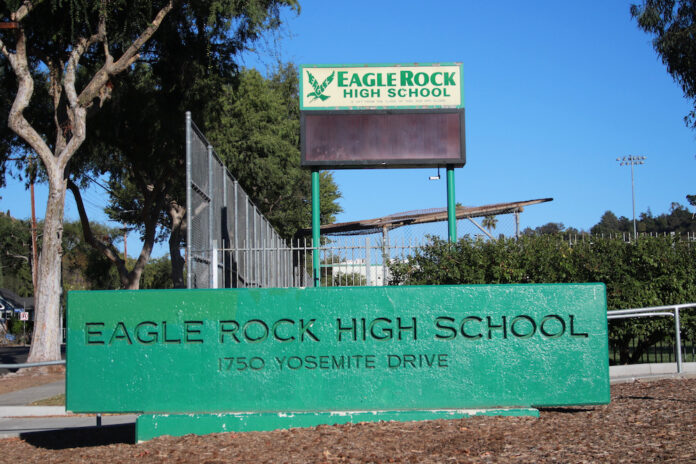
Los Angeles Unified School District (LAUSD) re-opened their doors to students Aug. 15 with a $350 million effort to curb the spread of the virus in their schools. The district has implemented new policies for testing and contact tracing, as well as a Sept. 9 vaccine mandate for students 12 years or older without medical exemptions.
LAUSD is the first major school district in the country to implement such a measure. If students fail to be fully vaccinated by January 10, 2022, they will not be permitted on school campuses and will be referred to City of Angels, an online independent study program, according to The New York Times.
With 600,000 students, 70,000 employees and more than 1,000 schools across LA, LAUSD is the second-largest school district in the United States. The reopening costs a total of $350 million for 500,000 weekly tests, 1,000 healthcare workers and 30 lab technicians, according to the LA Times. LAUSD, a historically underfunded school district, will pay $80 million and request the federal government to pay the rest, according to the Washington Post.
LAUSD has implemented weekly in-school nasal swab testing and contract tracing. The school district also launched the DailyPass app, a tool that generates daily passes for visitors to enter school buildings.
The DailyPass app requires anyone entering an LAUSD school building to fill out a health check form and confirm that they have tested negative for COVID-19 in the last 14 days. According to Jessica Dirkes, professor of public health at Occidental and mother of two children in LAUSD, the DailyPass has become a part of her and her children’s daily lives.
“It’s gone pretty smoothly once we got into the rhythm of it,” Dirkes said. “Each morning, I have to log in and generate a DailyPass for them. Each week, I get a notice that they’ve been tested. It’s just a part of their routine.”
For testing, LAUSD contracted with SummerBio and UCLA SwabSeq for test kits and services, while Infiniti Health and AMI Expeditionary Healthcare provide testing staff to the district’s schools. According to Laura Morgan, the mother of a sophomore at Eagle Rock High School, parents are notified if their child has been exposed to the virus, or if anyone at school tests positive for COVID-19. LAUSD also has a scorecard with a publicly available directory with the number of cases at every school in the district.
Morgan said in-school testing has made her life as a parent easier.
“I like that they get tested at school because I’m a full-time single parent and I don’t have time to do those things separately,” Morgan said. “I really appreciate that it’s done on site.”
Morgan said she feels comfortable with how the reopening has been handled but is nervous that teenagers might not follow mask and social distancing guidelines during non-school hours. Though social distancing is encouraged by LAUSD, it is not required. According to Scott Martin-Rowe, a librarian at Miguel Contreras Learning Complex, distance can be hard to enforce even while schools are in session, especially during lunch when students do not wear masks.
“At lunch, it’s a different story. Students are out free, roaming around. Sometimes, they’re not even one inch apart,” Martin-Rowe said. “If anything happens, that’s when it’ll happen, in my opinion.”
According to an LAUSD report on remote learning, 3 percent of district students — 18,000 in total — did not log on once during the entire year of distance learning. The report found that students who were Black, Hispanic or Latino, living in low-income households, English learners, homeless or in foster care were consistently behind their peers in the district with regards to their studies and curriculum. According to Martin-Rowe, remote instruction was incredibly difficult for many students.
“I think what’s going to be interesting is the academic, social, emotional fallout from this last year,” Martin-Rowe said. “There are a lot of kids that were a year behind, and now they are two and a half years behind.”
Dirkes said she felt a deep concern for the students who did not log on during the pandemic. She said she feels the reopening was somewhat disorganized in the first weeks of school but is still better than continuing distanced learning.
“Any frustrations are worth it. I think that this gap and inequity meant that we did have to open back up,” Dirkes said. “From an equity standpoint, it’s really detrimental to have this go on because the kids that came from families with resources were able to navigate it in a different way than children whose families have fewer resources.”
Morgan said her child has been happy to return to school and that the reopening has allowed her child to see friends more and to be more active by joining extracurricular activities like volleyball.
“I like how it is right now. I don’t think anyone likes wearing a mask, but it’s working, and it’s keeping down cases of not only COVID but also the flu,” Morgan said. “The opening of schools is a safeguard for all of our children. It’s been fantastic for our family.”
![]()


































